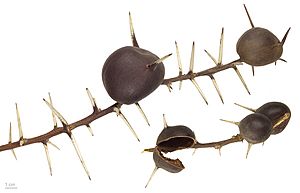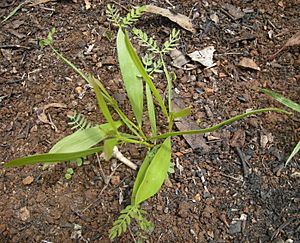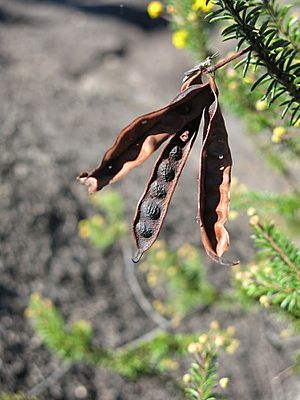Wattles facts for kids
Quick facts for kids Wattles |
|
|---|---|
 |
|
|
|
|
| Scientific classification | |
| Kingdom: | |
| Division: | |
| Class: | |
| Order: | |
| Family: | |
| Subfamily: | |
| Tribe: | |
| Genus: |
Acacia
|
| Species | |
|
About 1,300; see List of Acacia species |
|
Acacia, also known as wattles, is a large group of shrubs and trees. They belong to the pea family, Fabaceae. These plants were first found in Africa and Australia. The famous scientist Carl Linnaeus described the first Acacia species.
Scientists have found Acacia fossil pollen in Australia from about 25 million years ago. Today, many Acacia species grow all over the world. People have even planted huge Acacia farms, covering millions of acres. Acacia plants can look very different. Some are low-growing shrubs, while others are tall canopy trees in forests.
Contents
How Acacia Plants Protect Themselves
Acacia trees have amazing ways to protect themselves from animals that want to eat them. Different Acacia species use different defense methods.
Thorns and Whistling Thorns
Many Acacia species have sharp thorns. For example, the whistling thorn Acacia has pairs of thorns that are about 5 cm long. These thorns stick out almost at a right angle. Some even grow from a small pod.
Tiny ants live inside these pods. The ants cut small holes to get in and out. If an animal disturbs the branch, the ants swarm out. They are ready to bite anything that touches their home.
Chemical Defenses
Acacia plants also use chemicals to protect themselves. Many species have bitter substances called tannins. These tannins can make up to 40% of the plant's bark. They make the plant taste bad to herbivores. Some Acacia species also contain special chemicals called alkaloids.
Ants as Bodyguards
In Africa and Central America, some Acacia trees have a special relationship with ants. This is called symbiosis. The ants live on the Acacia and protect it from many enemies. These enemies can be as big as elephants or as small as caterpillars and beetles.
Some of these ants even fight off other plants growing too close to the Acacia. They cut off the leaves of competing plants with their jaws. This helps the Acacia tree grow better.
Where Acacia Plants Grow
Acacia plants can grow in many different places. You can find them in cold alpine areas, wet rainforests, dry woodlands, open grasslands, sandy coastal dunes, and even deserts. In drier forests, they are an important part of the plants growing under the main trees.
In Australia, Acacia forests are the second most common type of forest. They cover a huge area, about 980,000 square kilometers. This is about 8% of all the forest land in Australia. Acacia is also the largest group of flowering plants in Australia, with almost 1,000 different species.
How People Use Acacia Plants
Aboriginal Australians have used Acacia plants for a very long time. They traditionally collected the seeds from some species. They would grind these seeds into flour. This flour could be eaten as a paste or baked into a cake. Acacia seeds have a lot of protein, about 25% more than common cereals. Their hard outer coats also help them stay good for a long time.
Besides the edible seeds and gum, Aboriginal people used Acacia wood. They made tools, weapons, and musical instruments from it. They also used it for fuel.
Economic Uses of Acacia
Many Acacia species are important for the economy around the world. They are widely planted for their wood. This wood is used for many products. Acacia trees also provide tannin, which is used in leather making. They are also a good source of firewood and fodder for animals.
The Book of Exodus in the Bible mentions Acacia wood. It was used to build the Tabernacle. This might have been the Acacia raddiana species.
Acacia and Butterflies
Acacia plants are a common food source for certain butterflies. Butterflies of the genus Jalmenus often feed on Acacia trees. For example, the Jalmenus evagoras butterfly eats at least 25 different Acacia species.
Acacia Gum and Its Uses
The hardened sap from various Acacia trees is known as acacia gum. This gum has many different uses.
- It is used as an emulsifier in food. This means it helps mix ingredients that normally don't mix well.
- It acts as a binder for watercolor paints.
- It is added to ceramic glazes.
- It helps bind things together in photography.
- It provides a protective layer in lithographic processes.
- It is used as a binder to hold fireworks together.
Medicinal Uses and Safety
Products from Acacia have sometimes been used for medicine. However, it's important to know that some Acacia species contain special chemicals called psychoactive alkaloids. These can affect the mind. Also, some species contain potassium fluoroacetate, which is a poison.
Images for kids
-
Wattle sign. Olive Pink Botanic Garden, Alice Springs. 2005
See also
 In Spanish: Acacia para niños
In Spanish: Acacia para niños







